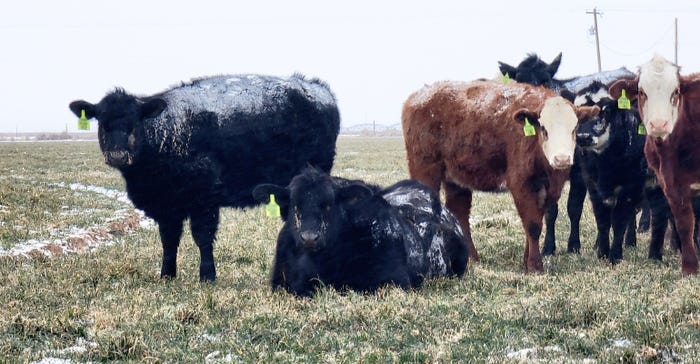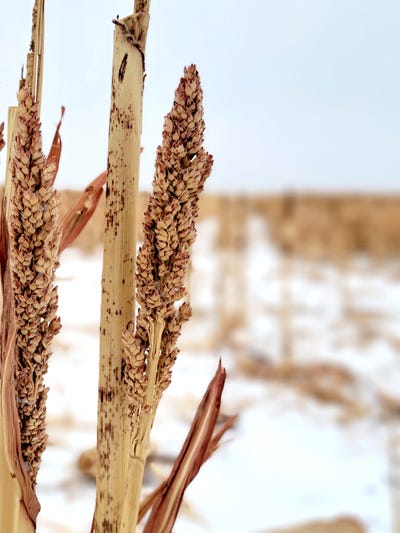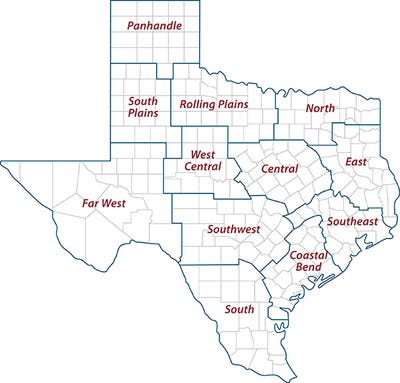
Commodity crop prices continue to remain strong across the board as weather and geopolitical concerns add volatility to markets, according to a Texas A&M AgriLife Extension Service expert.
Mark Welch, AgriLife Extension grain economist, Bryan-College Station, said drought conditions in both hemispheres are raising questions about global crop yields while troops amass in a region that supplies one-third of the world’s wheat.
Welch said commodity crop prices are better compared to this time last year. Prices provide an improved opportunity for producers to profit even with the higher input costs factored into production budgets.
“We’re seeing competitive prices among all commodities, and there are a lot of questions surrounding various crops here and across the world,” Welch said. “These questions will likely play a role in Texas producers’ planting decisions. Costs are up as well, but commodity crop prices are still good relative to those increases.”
Wheat off to a bad start due to drought
Welch said planted acres of wheat across the Southern High Plains, including much of Texas and Oklahoma, were in “rough shape” due to drought. There have been reports of emerged wheat fields being lost to dry conditions. But there is still time for dryland wheat to recover and make a crop.
Wheat is struggling, but plants in most parts of Texas are still dormant, Welch said. Moisture will be needed before temperatures begin to climb and plants try to put on new growth.
 (photo by Shelley E. Huguley)
(photo by Shelley E. Huguley)
“We still have some time,” he said. “Wheat is in bad shape, but it also was this time last year before a snow around Valentine’s Day that saved the crop. The weather improved after that, and many fields performed well for most of the state.”
Welch said growing conditions are better in Kansas, the nation’s No. 1 wheat-growing state. Areas do need rain, but fields there also have more time to receive and respond to better weather.
Commodity crop prices represent opportunity, options for farmers
Welch said the wheat market has been volatile recently due to tensions in Ukraine and Russia. The two nations account for 30% of global wheat exports, and conflict would disrupt trade and affect prices.
“It is important to recognize that high wheat prices are a signal to producers around the world to plant more, but crops depend on the weather and whether crops can grow in certain areas and balancing acres with other needs,” he said.
 (photo by Shelley E. Huguley)
(photo by Shelley E. Huguley)
Grain marketers, especially corn and soybeans, are also watching production in South America, where drought is a concern and causing upward price trends, Welch said. The demand for domestic corn is up due to feed and fuel. Export demand for domestic corn has been high of late, with Mexico, the No. 1 buyer of U.S. corn, ramping up purchases and China continuing to buy as well.
Cotton and sorghum are also demanding high prices, which means farmers can expect to have options based on their budgets, rotation schedules, and soil moisture and rainfall expectations, Welch said. Sorghum, for instance, is more drought-hardy than corn and generally costs less per acre to produce.
But because of high input costs, Welch said 2022 is a year to maximize efficiencies for every dollar spent.
“The risk management challenge is around marketing this year,” he said. “We know the high input prices are here and likely sticking around by planting time, but we want to make sure we don’t let the opportunity for high prices at harvest slip away.”
AgriLife Extension district reporters compiled the following summaries:

CENTRAL
Drought conditions were intensifying. Spotty rainfall provided moisture, up to half an inch in some areas, but much will be needed before spring planting. Several hard freezes injured oat and wheat crops during January. Both crops were recovering, but another round of deep frost conditions was in the forecast. Local crop scouts reported a very light infestation of Hessian flies and some mites in tillering winter wheat. Some winter wheat was showing signs of low fertility levels and patchy leaf necrosis caused by the heavy frosts. Winter oat crops were widely grazed, and livestock were in excellent condition. Stock ponds were still holding water. Winter annual weed spraying was coming to an end in wheat, and pre-emergence applications were being made to corn acres. Distributors reported a flurry of corn seed purchases due to weather outlooks calling for significant precipitation in the coming weeks.
ROLLING PLAINS
The district needed rainfall. Several fires were reported, and fire dangers remained a concern. Stocker cattle on wheat were being supplemented with hay. Dryland wheat was primarily in very poor condition. Some dryland wheat fields were dried up or never emerged. Irrigated wheat was struggling in some areas. Pasture conditions were poor as well. Beef, goat and sheep producers were providing supplemental feed for animals.
COASTAL BEND
Conditions remained dry, but rain was in the forecast. Row crop producers were preparing for planting, and some were still putting out fertilizer. Livestock were doing well. Dry conditions have hampered pasture growth, and producers were feeding hay and protein. Hay supplies were still good. Some herds started calving, and cattle market prices remained high.
EAST
More rain was needed across the district. Many counties have had little to no rain for extended periods. Pasture and rangeland conditions were poor to very poor. Subsoil and topsoil conditions were short to adequate. Winter pastures needed more moisture to continue growth. Livestock were doing fair to good for some supplementation taking place. Producers were looking for alternative fertilizer options due to the current high prices of traditional fertilizers. Wild pigs remained a major problem in some areas.
SOUTH PLAINS
Moisture was needed districtwide.
PANHANDLE
The district received snow, but conditions remained very dry. Emerging winter wheat fields were in a holding pattern with little soil moisture. Soil moisture conditions were very short in nearly all counties. Overall, rangeland and pasture conditions were very poor to poor.
NORTH
Topsoil moisture was very short to short. Areas of the district were reporting extreme drought conditions. Temperatures were average for this time of year. The lack of precipitation and high fertilizer prices were causing many wheat growers to consider delaying or splitting fertilizer applications based on cost and forecasts. Other wheat and oat producers reported fields were in decent shape but needed more precipitation. Livestock were in good condition, but pasture soil moisture and pond levels were becoming a concern.
FAR WEST
Temperatures were in the mid-20s to the low 30s overnight, with daytime temperatures in the mid-40s to the high 60s. Producers were preparing for a strong cold front. Trace amounts of rain were reported. No dryland wheat had emerged, and irrigated wheat only came up directly above drip tapes. Some fieldwork began including light discing of stalks and chiseling. Pastures were bare of grass and forage for cattle. Cold, windy weather forced producers to increase hay and protein rations to keep livestock warm. Producers were reporting difficulties this calving season, and predators were very active. Producers continued to sell off calves and poorer cows. Most pecans were harvested, and producers were beginning to prune trees and clean orchard floors. Lambing and kidding should begin in the next few weeks.
WEST CENTRAL
Conditions remained very dry. The cotton harvest was completed. What little wheat had emerged began to die out due to wind, drought and cold temperatures. Rangeland and pastures were in poor to fair condition. Most livestock producers began to feed relatively heavy. Sheep and goats were doing surprisingly well, and numbers were steady.
SOUTHEAST
Most areas remained dry, but a cold front and multiple days of rain were in the forecast for several counties. Soil moisture levels were adequate to very short. Chambers County reported receiving rains with four days of rain in the forecast. Pasture forages were declining, but the quality remained good. Home gardeners were beginning to prepare for early spring planting. Wheat and oat fields needed rain. Most livestock were being fed supplemental hay and/or protein.
SOUTHWEST
Conditions were dry, and rangeland and pasture conditions remained poor. Row crop farmers continued to prepare for planting.� Winter wheat under irrigation looked relatively good, while dryland wheat was struggling. Oats were not adding new growth. Producers were providing heavy amounts of supplemental feed to livestock and wildlife. Goat and sheep prices remained steady to high. The cattle market remained steady. A slight chance of precipitation was in the forecast, along with a strong cold front.
SOUTH
Many areas reported rainfall, with areas reporting heavy mist to 1 inch of rain. Northern areas remained very short on moisture, while western areas reported short soil moisture levels despite rainy conditions. Western and southern areas reported adequate soil moisture. Temperatures were cooler, and a cold front was in the forecast. Row crop fields will need significant rainfall for preparations and planting. Winter vegetables looked good. Producers were preparing to plant corn, sunflowers, and grain sorghum. Corn producers were being delayed by wet field conditions in some areas. Citrus and sugarcane harvests continued. Bermuda grass was brown following frost events. Rangelands were dormant, and producers were providing heavy rations of supplemental feed to livestock. Stock tanks were in decent shape. Cattle prices were steady, but supplemental feed prices were up. Some producers continued to thin their herds.
Source: is AgriLife TODAY, which is solely responsible for the information provided and is wholly owned by the source. Informa Business Media and all its subsidiaries are not responsible for any of the content contained in this information asset.
About the Author(s)
You May Also Like




